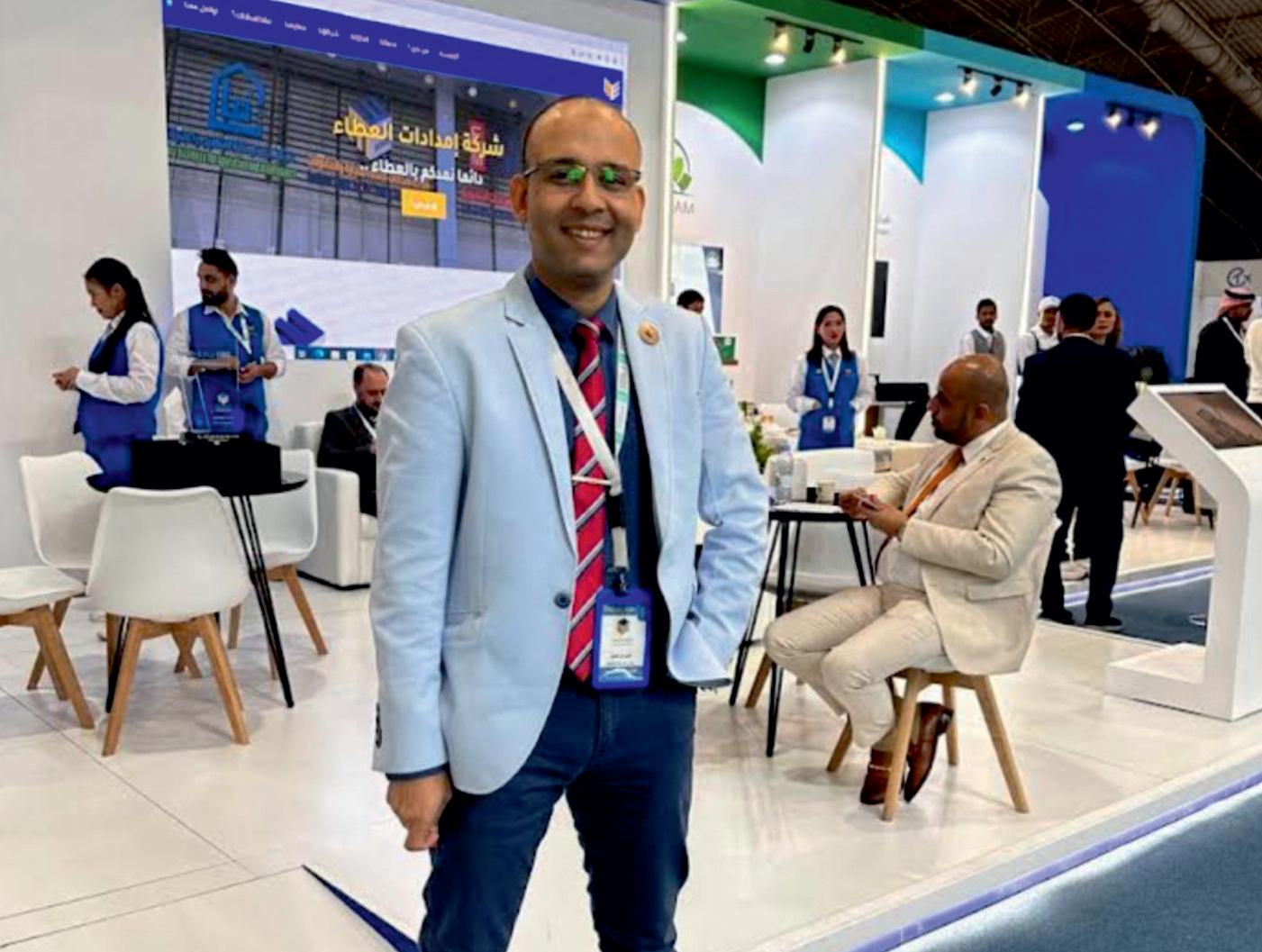Most Inspiring LEADERS SETTING
The Bar For EXCELLENCE In 2024

Transforming the Future of Finance










The Bar For EXCELLENCE In 2024

Transforming the Future of Finance









hilecompetenceinmanagementiscommon,thegiftofinspirationis
rare, separating exceptional leaders from the rest.At the core of this exceptional trait lies a potent blend of vision, mission, and integrity thatdrivesleaderstomakeapositiveimpactontheworldaroundthem.
Inspirationalleadersaredrivenbyadeep-seatedsenseofpurpose.Theyviewtheir rolenotasamerejobbutasacallingtoeffectmeaningfulchange.Theysteadfastly uphold their values, even in the face of adversity, refusing to compromise. This devotion,althoughitmaynotalwayswinthempopularity,earnsthemsomething farmorevaluable:thetrustandrespectoftheirteam.
Adherence to integrity is central to the ethos of inspirational leadership. These leadersunderstandthateveryactiontheytakeisscrutinizedbythosetheylead.As such, they conduct themselves with honor and authenticity, ensuring that their behavioralignswiththeircorevalues.Thisconsistencybreedstrustandfostersa cultureofaccountabilitywithintheirteams.
Under inspirational leadership, successful teams are united by a shared sense of purpose and camaraderie. They come together to collaborate, share knowledge, andleverageeachother'sstrengthstoachievecommongoals.Thiscollaborative spiritnurturesastrongsenseofbelongingandunity,drivinggreaterengagement andproductivityacrosstheorganization.
In its latest edition, “Most Inspiring Leaders Setting the Bar for Excellence in 2024,” InsightsSuccessshowcasesthestoryofavisionaryleaderwhoisdriving innovation and shaping the future of the modern industry with exceptional leadershiptraits.
Asyouflipthroughthepagesofthisedition,you'llencounterataleofresistance, willpower, and boldness in the face of adversity You'll learn how this leader overcame challenges, seized opportunities, and ultimately transformed their organizationsandindustriesforthebetter.
So,diveinandletyourselfbeinspiredbythestoryofthisremarkableleaderwhois making waves in the world of business. His journey, promise of superiority, and passionforinnovationaresuretoleavealastingimpression.
Haveagoodreadahead!








Sabry Mohamed Transforming the Future of Finance
14.
What Can You Do with a Degree in Organiza�onal Leadership?
18.
Leadership Redefined: Mo�va�ng Others to Achieve Shared Goals
20.
Le�ng Go: Why the Best Execu�ves Know When to Step Back
22. What Strategies Do Successful Leaders Use to Manage Conflict?

My growth mindset and nevergiving-up attitude have shaped my problem-solving skills. Perseverance and learning from my mistakes helped me develop analytical and problem-solving abilities that have helped me even today as a CFO at Emdadat Alatta Group.”



Sabry Mohamed
Group Chief Financial Officer, Emdadat Alatta Group










Thevalueofadegreein
organizationalleadership stretchesfarbeyond conventionalleadershiproles.This comprehensiveprogrammolds individualsintoversatileleaders capableofnavigatingthecomplexities ofmodernworkplaces.Itblends theoreticalknowledgewithpractical applications,ensuringgraduatesare readytomakeatangibleimpactin varioussectors.Thisarticledelvesinto themyriadopportunitiesthatawait thosearmedwithadegreein organizationalleadership,highlighting thediversityandpotentialofcareer pathsavailable.
Oneofthemostdirectapplicationsof anorganizationalleadershipdegreeis inmanagement.Thisfieldopensdoors tooverseeingdepartments,guiding teams,andleadingprojects.Managers equippedwithleadershipskillsare adeptatmotivatingstaff,resolving conflicts,andimplementingstrategies thatdriveorganizationalobjectives. Theyactasthelinchpinbetween executivevisionandoperational execution,ensuringgoalsaremet efficientlyandeffectively.
Inaworldwhereeducationoften

correlateswithcareeradvancement, thoselookingtoelevatetheir leadershipcapabilitiesmayconsider furtheringtheirstudies.Pursuingan onlinemastersdegreeinorganizational leadershipfromWilsonCollege,for example,allowsindividualstodeepen theirunderstandingofcomplex organizationalstructures,enhance strategicdecision-makingskills,and specializeinareassuchaschange managementorleadershippsychology. Thisadvanceddegreecancatapult professionalsintohigherechelonsof leadership,openingupopportunities forexecutivepositionsandspecialized consultingroles.
Therealmofhumanresources(HR) greatlybenefitsfromtheinsightsand skillsdevelopedthroughan organizationalleadershipdegree.HR professionalsplayacriticalrolein shapingtheworkforce,from recruitmentandtrainingto performancemanagementand employeeretention.Understanding organizationaldynamicsand possessingstrongleadershipskills enablesHRpractitionerstobuilda culturethatattractsandretainstop talent,alignsemployeeobjectiveswith companygoals,andfostersapositive, productiveworkplaceenvironment.
Consultingisadynamiccareerpath thatallowsorganizationalleadership graduatestoleveragetheirexpertise acrossvariousindustries.As consultants,theyhelporganizations navigatechange,improve performance,anddevelopstrategies forgrowth.Theirabilitytodiagnose problems,proposesolutions,andguide leadershipthroughtransformation processesmakestheminvaluable assets.Thiscareerofferstheflexibility toworkondiverseprojects,constantly challengingandexpandingone'sskill set.
Thenonprofitsectoroffersaunique avenuefororganizationalleadership graduatestoapplytheirskillstoward mission-drivenobjectives.Leadinga nonprofitrequiresadelicatebalanceof businessacumenandsocial commitment,astheseleadersmust manageresourcesefficiently,engage stakeholders,anddriveimpact.The leadershipqualitieshonedthroughan organizationalleadershipdegreeequip individualstonavigatethechallenges ofnonprofitmanagement,from fundraisingandvolunteercoordination toprogramdevelopmentand communityengagement.

Entrepreneurswithabackgroundin organizationalleadershiphavea distinctadvantage.Theypossessthe strategicvisiontoidentifymarket opportunities,coupledwiththe leadershipskillstomobilizeresources anddrivestartupsuccess.Leadership trainingpreparesthemtofacethe uncertaintiesofentrepreneurship,from scalingtheirbusinesstonavigating competitivelandscapes.Byapplying principlesofeffectiveleadership, entrepreneurscanbuildcohesive teams,fosterinnovation,andestablish astrongorganizationalculturethat sustainsgrowthandadaptstochange.
Thefieldofeducationaladministration isanotherareawhereadegreein organizationalleadershipproves invaluable.Leadersineducation,such asschoolprincipals,district administrators,anduniversitydeans, benefitfromthestrategicplanning, teambuilding,andorganizational managementskillsacquiredthrough thisdegree.Theyaretaskedwith shapingeducationalpolicies, improvingschoolsystems,and ensuringthateducationalinstitutions meettheneedsofstudentsand communities.Theleadershipqualities honedthroughtheirstudiesenable themtodriveeducationalreformand makealastingimpactonthefutureof learning.
Graduatesoforganizationalleadership programsarewell-suitedforroles withingovernmentagencies.These positionsoftenrequiretheabilityto managecomplexprojects,leaddiverse teams,andnavigatetheintricaciesof publicadministration.Withskillsin
strategicplanning,ethicalleadership, andeffectivecommunication, individualscancontributetopolicy development,publicservice improvement,andthemanagementof governmentinitiatives.Leadershipin thiscontextinvolvesacommitmentto publicinterest,transparency,andthe efficientuseofresourcestoservethe community.
Thehealthcaresectorincreasingly recognizestheneedforstrong leadershiptomanagehospitals,clinics, andothermedicalfacilities.Adegree inorganizationalleadershipequips individualstohandlethechallengesof healthcaremanagement,including operationalefficiency,patientcare quality,andregulatorycompliance. Leadershipskillsenablehealthcare managerstoleadmultidisciplinary teams,optimizeresourceallocation, andimplementinitiativesthatimprove patientoutcomesandoperational performance.Thisroledemandsa balanceoftechnicalknowledgeand interpersonalskillstonavigatethe complexitiesofthehealthcare environment.
Specializingintrainingand developmentallowsorganizational leadershipgraduatestofocuson enhancingworkforcecapabilities.With adeepunderstandingoflearning principlesandorganizationalbehavior, theseprofessionalscreateengaging learningexperiencesthatalignwith strategicgoals.Theyplayacriticalrole infosteringacultureofcontinuous improvementandadaptability, ensuringorganizationsremain competitiveinarapidlychanging businesslandscape.
LeadershipinCSRisapathwayfor graduatestoapplytheirskillstowards ethicalbusinesspractices, sustainability,andcommunity engagement.Thisroleinvolves developingandimplementingCSR initiativesthatreflecttheorganization's commitmenttosocialand environmentalresponsibility
Organizationalleadershipskillsare criticalinaligningCSReffortswith businessobjectives,engaging stakeholders,andmeasuringtheimpact oftheseinitiatives.Leadersinthisarea drivepositivechange,enhancingthe organization'sreputationand contributingtoasustainablefuture.
Adegreeinorganizationalleadership opensaworldofpossibilitiesacrossa diverserangeofsectors.From entrepreneurshipandeducationto governmentandhealthcare,the leadershipskillsacquiredare universallyapplicableandhighly valued.Thesecareerpathsoffernot onlyprofessionalgrowthand advancementopportunitiesbutalsothe chancetomakeameaningfulimpactin organizationsandcommunities.Asthe needforeffective,ethical,andadaptive leadershipcontinuestogrow,those equippedwithadegreein organizationalleadershiparewellpositionedtomeetthesechallenges andleadthewaytowardabrighter, moreinclusivefuture.


Thetraditionalimageofaleader
asacommandingfigure, issuingordersfromthetop,is rapidlyevolving.Today'seffective leadersaremoreakintofacilitators, inspiringandguidingteamstowards sharedobjectives.Thisshift necessitatesaredefinedapproachto leadership,onethatprioritizes motivationandcollaboration.
Atthecoreofthisnewleadership paradigmistheunderstandingthat peoplearenotmerelyresourcesbut individualswithuniquestrengths, aspirations,andmotivations.To harnessthefullpotentialofateam, leadersmustcultivateacultureoftrust, respect,andempowerment.By creatinganenvironmentwhere individualsfeelvaluedandengaged, leaderscanunlockextraordinarylevels ofperformance.
Motivation,thedrivingforcebehind humanaction,isacriticalcomponent ofeffectiveleadership.Whileextrinsic rewardslikebonusesandpromotions canprovideshort-termincentives, intrinsicmotivation,derivedfroma senseofpurpose,autonomy,and mastery,isfarmoresustainable. Leaderswhocantapintotheintrinsic motivationsoftheirteammembersare morelikelytobuildhigh-performing andresilientteams.
Toinspireintrinsicmotivation,leaders mustfocusoncreatingasharedvision. Acompellingvisionprovidesasense
ofpurposeanddirection,inspiring individualstocontributetheirtalents andenergytowardsacommongoal. Byinvolvingteammembersinthe vision-buildingprocess,leaderscan fosterasenseofownershipand commitment.
Furthermore,effectiveleaders empowertheirteammemberstomake decisionsandtakeownershipoftheir work.Micromanagementstifles creativityandinnovation,while autonomyfostersasenseof responsibilityandaccountability.By delegatingtasksandprovidingthe necessarysupport,leaderscreatean environmentwhereindividualscan thriveanddeveloptheirskills.
Buildingstrongrelationshipsisanother essentialaspectofmotivatingothers. Trust,respect,andempathyarethe cornerstonesofeffectiveleadership. Byactivelylisteningtoteammembers, understandingtheirneedsand concerns,andprovidingsupportand guidance,leaderscancreateapositive andsupportiveworkenvironment.
Effectivecommunicationiscrucialfor aligningteammemberstowardsshared goals.Leadersmustbeclearand conciseintheircommunication, ensuringthateveryoneunderstandsthe expectationsandpriorities.Regular feedbackandopendialogueare essentialformaintainingalignmentand addressingchallenges.
Inadditiontomotivation,leadersmust alsofocusondevelopingthe capabilitiesoftheirteammembers.By providingopportunitiesforlearning andgrowth,leaderscanhelp individualsreachtheirfullpotential. Coaching,mentoring,andproviding accesstodevelopmentresourcesare essentialforbuildingahighperformingteam.
Ultimately,leadershipisaboutserving others.Byfocusingontheneedsand aspirationsoftheirteammembers, leaderscancreateapositiveand inspiringworkenvironment.By empoweringindividualstocontribute theiruniqueperspectivesandtalents, leaderscanunlockthefullpotentialof theirteams.
Intoday'srapidlychangingworld,the roleoftheleaderisevolving. Successfulleadersarethosewhocan inspireandmotivateotherstoachieve sharedgoals.Bybuildingtrust, empoweringindividuals,andfostering acultureofcollaboration,leaderscan createhigh-performingteamsthat driveorganizationalsuccess.


Thequintessentialimageofa successfulexecutiveisoneof unwaveringdetermination, relentlessdrive,andanirongriponthe reinsofpower Yet,paradoxically,the mosteffectiveleadersoftenunderstand theartoflettinggo.It’sa counterintuitiveconcept,buttheability tostepback,delegate,andempower othersisahallmarkofexceptional leadership.
Manyexecutivesrisetothetop becauseoftheirexceptionalskillsand abilitytodeliverresults.However, whatgotthemtheremightnotbethe beststrategyforscalingabusinessor fosteringlong-termgrowth.Atendency tomicromanage,whileunderstandable, canbedetrimental.
Itstiflesinnovation,demoralizes employees,andpreventsthe organizationfromreachingitsfull potential.
Moreover,excessiveinvolvementin day-to-dayoperationscanhinder strategicthinking.Leaderswhoare constantlyfirefightingarelesslikelyto havethetimeormentalspacetofocus onthebigpicture,suchasindustry trends,competitivelandscape,orlongtermvision.
Successfulexecutivesrecognizethat theirroleevolvesovertime.Insteadof beingtheprimaryproblem-solver,they becomearchitectsoftheorganization's future.Thisrequiresnurturingand developingastrongleadershipteam. Bydelegatingauthorityand responsibility,executivescreate opportunitiesforotherstoshineand grow Thisnotonlybuildsarobust leadershipbenchbutalsoinstillsa senseofownershipandaccountability amongemployees.
Determiningtherighttimetostepback isacomplexdecision.Thereare severalindicatorsthatmightsignalthe needforachangeinleadershipstyle:
• Stagnation:Iftheorganizationis plateauingdespiteconcerted efforts,itmaybetimetoinject newperspectivesandenergy
• Burnout:Excessivestressand exhaustioncanimpairjudgment anddecision-making.
• LossofPassion:Iftheexecutive’s enthusiasmfortheroleiswaning, itmightbetimetoconsidera transition.
• NewOpportunities:Sometimes, steppingbackfromoneroleopens doorstoevenmoreimpactful opportunities.
Lettinggoisnotaboutabdicating responsibility.It’saboutcreatinga sustainable,thrivingorganizationthat cancontinuetosucceedlongafterthe founderorCEOhasdeparted.By empoweringothers,executivesbuilda legacyofleadershipdevelopmentand organizationalexcellence.
Ofcourse,steppingbackiseasiersaid thandone.Itrequiresahighdegreeof self-awareness,humility,andtrustin others.Italsoinvolvescarefulplanning andexecutiontoensureasmooth transition.Buttherewardsare immense.Bylettinggo,executivescan freethemselvestofocusonhigherlevelstrategicinitiatives,while simultaneouslycreatingamore engaged,empowered,andresilient organization.
Inconclusion,theabilitytoletgoisa crucialleadershipcompetency.It’sa testamenttoaleader’sconfidence, wisdom,andcommitmenttothelongtermsuccessoftheorganization.By understandingwhenandhowtostep back,executivescancreatealasting impactthatextendsfarbeyondtheir tenure.


Effectiveleadershipoftenhinges
ontheabilitytonavigate conflictwell.Somelevelof conflictisinevitableinwork environments;whenitdoesarise, successfulleadersmanageitwitha mixofempathy,clarity,and decisiveness.
Considerasituationinabustlingoffice wheredifferingopinionsonaproject leadtoraisedvoices.Aproficient leaderintervenesnotmerelytosilence thediscord,buttounderstandthe underlyingcausesandguidetheteam towardscommonground.
Suchleadersmaintainteamharmony andmorale,ensuringthatconflict, whenitoccurs,becomesastepping stonetowardsgreaterunderstanding andteamsynergy,ratherthana stumblingblock.Theirapproachis pivotalinsustainingaharmoniousand productiveworkenvironment.There aremanystrategiesthatsuccessful leadersusetomanageconflict:
Whenateammemberfeelsfrustrated, agreatleaderwillputtheirown opinionsaside andlistenintently Theyfocusentirelyonunderstanding thespeaker'sthoughtsandemotions.

Forexample,whenemployees disagree,aleadermightaskopenendedquestionstograspboth perspectives.Thishelpsfindcommon ground.Byclearlyacknowledging everyone'sfeelingsandconcerns, leadersbuildtrustandcreatea comfortableenvironmentwhereteams knowtheycanexpresstheirconcerns safelyandwithoutjudgement.
Thisensuresthatemployeesknowthey arevaluedandwillbeheard.Through activelistening,leadershelpnavigate conflicteffectively,andmaintaina harmoniousworkplace.
Agoodleaderknowshowtohandle disputeseffectively,notjustby listeningandprovidingsolutions themselves,butbyhelpingteamsdo thistogether.Managers focuson bringingteamstogetherandfinding commonground,makingeveryonefeel heardandrespectedbytherestofthe team.
Whenleadersusethisapproach,they oftenfindsolutionsthatworkforall involved.Forexample,inaworkplace, amanagermightsitdownwithteam memberswhodisagree.Byguiding themthroughacalmdiscussion,the
managerhelpsthemreachan agreementthatworksforbothofthem, andmakesthemfeelincludedinthe decision-makingprocess.This helpsto boostteammoraleandproductivity
Mediatingconflictwithcompassion andempathyisjustoneofmany traitsofagoodleader,butit'san importantoneinthatitprovidesan opportunitytomodelrespectfuland effectivecommunication.
Leadersexcelatguidingtheirteams towardasharedvision,ensuring everyoneworksinharmony.For instance,ifateamhasabigproject comingupthattheyneedtogetright, communicatingeveryone’srolesand responsibilitiesclearlyisimportantin ensuringtheteamisonthesamepage, andnoissuesariselaterfromoverlaps inwork.Similarly,bringingtheteam togethertosetreallycleargoalsalso helpstominimisedisagreementsover individualapproaches.
Thisinclusiveapproachnotonly preventspotentialconflictsbutalso fostersastrongsenseofcommunity andpurpose.It'slikeafamilyplanning aholidaytogether—wheneveryone agreesonthedestination,it’smore likelytobeanenjoyableexperiencefor allinvolved.
Whenleadersestablishclearrules aboutacceptablebehaviour,itcan preventconflictsfromarising.
Consideramanageratacompanywho stipulatesthatmeetingsshouldfocus solelyonwork-relateddiscussions,not personalissues.Thisclarityensures thateveryoneunderstandsthe expectations,andnooneengagesin inappropriateconversationsthatcould makeothersuncomfortableandresult
inconflict.Shouldateammemberstart todiscusspersonalmattersduringa meeting,theleadercangentlyremind themofthisguideline,maintainingthe team'sfocusandpreventingdisputes.
Withclearboundariesinplace,team memberscancollaboratemore effectively,stayingontaskandgetting thejobdone.
Leadersoftengathertheirteamto addresschallengesasagroupwhen theyencounterproblems.Thisstrategy involvesopenlydiscussingeachteam members’perspectivestoforgea solutionthataccommodateseveryone. Similarlytomediation,collaborative problem-solvingrequiresaleaderto encouragecommunicationwithinthe team,althoughproblem-solvingis moreaboutpreventingdisputesthan dealingwiththemoncetheyarise.
Takethecaseofateamleaderata softwarecompanywhohasbeen contactedbyaclientwhonoticedtwo programmersusingdifferentsystems fortheirtasks,andthisisimpactingthe client’swork.Theleadercould organiseameetingtodiscussthe differentoptionsanddecideonone together Thiscouldpreventthe differencebecomingamuchbigger issuethatleadstoconflictwiththe client,orbetweenteammembers. Duringthissession,eachpersonshares theirthoughtsandconcerns.They explorewaystoblendthebest elementsofbothsystems.
Bytheendofthismeeting,theteam reachesaconsensusonanewapproach thatleveragesthestrengthsofthe originalsuggestions,allowingthe projecttoprogressefficiently.This approachnotonlypreventstheconflict butalsostrengthensthebondswithin theteam.
Effectiveleadershandleconflictsby treatingeveryoneequallyandapplying rulesconsistently
Inworkplaces,managerswhostickto theruleswhenresolvingconflictcreate anenvironmentwhereeveryoneknows exactlyhowthingswork.Employees knowwhattoexpectandbelievetheir concernsaretakenseriouslyand equally Thishelpsbuildastrongteam thatworkswelltogetherandavoids seriousconflictwhereverpossible.
Taketheexampleofagrocerystore managermediatingadisagreement betweentwoclerks—themanager mightremindthemofthestore’s respectpolicy,reassuringthemthat everyoneisheldtothesamestandards, beforelisteningtobothpartiesrecount theirexperienceanddiscontent,giving themthesametreatmentandtimetodo so.Dependingontheissue,the managerwillhavetomakeadecision aboutresolution,butfairnessand consistencywillbekeyintheprocess.
Successfulleadersmanageconflictin waysthatcangreatlyimproveboth harmonyandproductivityinthe workplace.Doingsoeffectively involvesviewingconflictnotasa hindrancebutasachancetostrengthen teambondsandencourageamore innovativeenvironment.
Managingdisagreementsisan unavoidablepartofleadership;when doneright,itcanresultinamore driventeamandconsequentlya healthier,forward-looking organisation.






